
Capercaillie (Photo: Terje Asphaug)
The research to understand the pattern of capercaillie productivity has resulted in three reports under a partnership comprising SNH, the Game and Wildlife Conservation Trust (GWCT), Forestry Commission Scotland (FCS) and the Royal Society for the Protection of Birds (RSPB).
Lead scientists from GWCT, with the support of partners, found capercaillie breeding success declined over 1991-2009. This decline was related to changes in weather conditions and increasing evidence of predators in capercaillie forests.
Previous studies linked the fortunes of capercaillie with the deaths of full-grown birds following collisions with deer fences and also poor breeding success associated with weather changes and high numbers of foxes and carrion crows which can prey on eggs, chicks, and even full-grown birds.
This new collaborative research published by SNH updates earlier findings. It repeated the 1995 survey of predators within key capercaillie forests and investigated how changes in predator evidence and weather might be related to breeding success over the 18 years.
Capercaillie breeding success and the density of female capercaillie in forests showed a significant decline. The former was due to fewer hens (female capercaillie) having reared chicks, rather than individual hens having fewer chicks each.
The research also found birds bred less well in forests in Perthshire, around the southern edge of their current range, than in Strathspey. Perthshire and Argyll and Moray recorded the highest declines in hen density. Only in the Strathspey sub-population were densities considered stable.
Measures of predator numbers or activity were derived from counts of raptors and crows seen by investigators in the field, and from mammal scats (faeces) found along forest tracks. The research found that while there was no change in crow or raptor numbers, the abundance of pine marten scats increased almost four-fold with fox almost three-fold.
The scientists identified that two different measures of productivity highlighted different issues. When weather and predator effects were considered together, the two key measures of productivity – ‘chicks per hen’ and ’broods per hen’ – were lower when April was warmer and in forests with more signs of pine martens and more crow sightings.
Hens were more likely to keep at least some of their brood – the ‘broods per hen’ measure – in years when the temperature rose sharply in April and when temperatures at chick-hatching time in June were higher. Brood size was lower when the weather at hatching time was wetter and in forests with more crow sightings.
Forests which displayed greater evidence of foxes were associated with the greatest declines in adult hen population density. The relationships with pine martens were not apparent until the weather was taken into account.
Dr Dave Baines of the GWCT said: “These findings are timely as the Scottish capercaillie population is now becoming critically low and its range is contracting. New conservation measures, alongside existing habitat works and continued efforts to minimise deaths on fences, are urgently required to help prevent a second extinction.
“Results from both this recent survey and work elsewhere in Scotland suggest weather and predators may combine to lower breeding success. Existing measures to control foxes and crows need to be increased, while the impact of the legally protected pine marten, known from other research to be an important predator of capercaillie eggs, needs to be carefully considered within the capercaillie’s remaining stronghold in Strathspey.”
And Rob Raynor of SNH stressed: “The work carried out so far points to an increase in pine marten evidence in woodlands occupied by capercaillie, but it is far from certain to what extent this might be a contributory factor in capercaillie productivity.
“More work is required to establish which, if any, of these factors actually influence capercaillie numbers.”
Dr Pete Mayhew of RSPB said: “With concerted effort we can reverse this worrying picture. While there is little we can do in the short term regarding climate change, we must now seriously address the issues of forest fragmentation, habitat quality, deaths from fence collisions, predation and human disturbance.”
